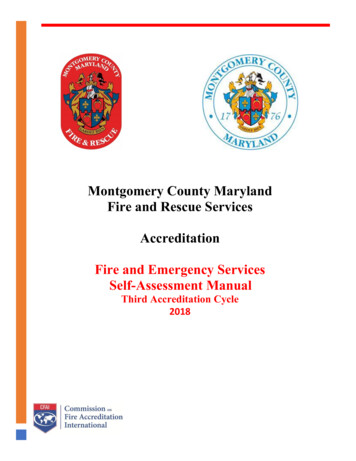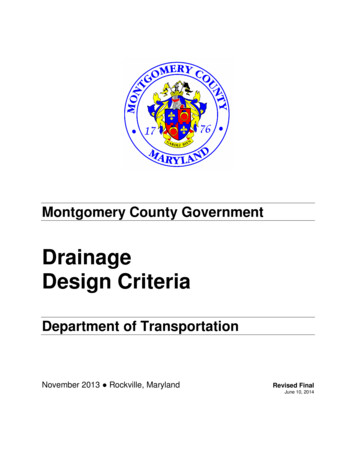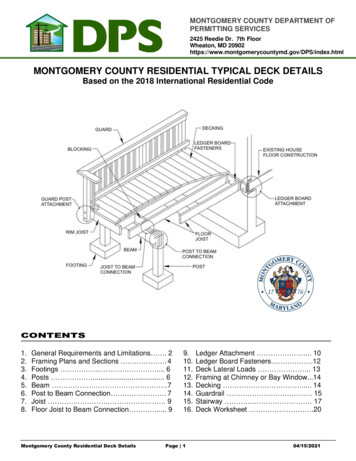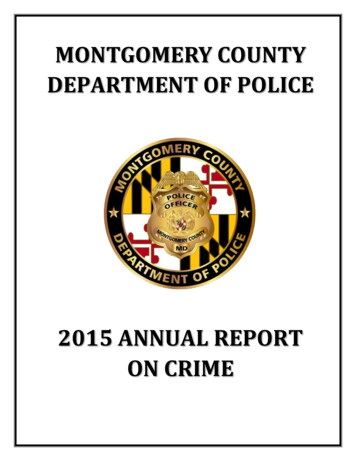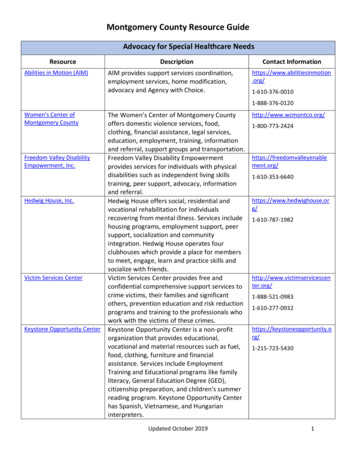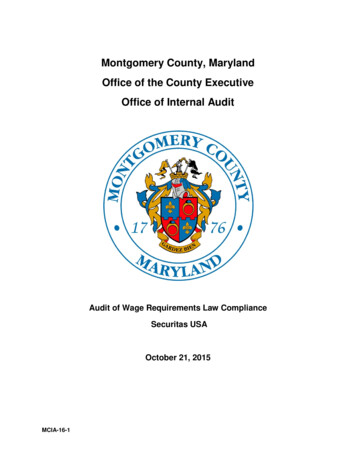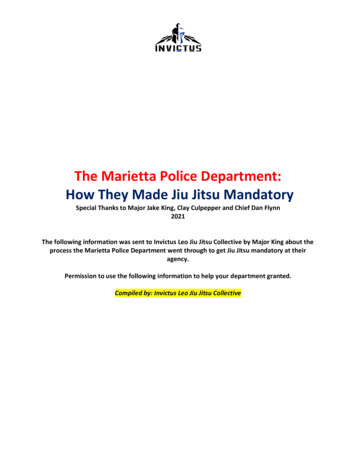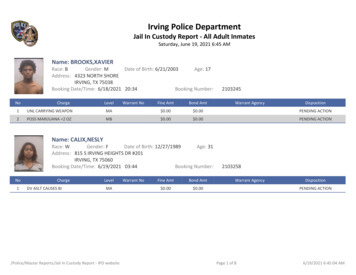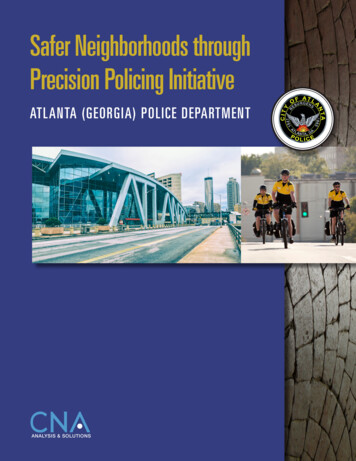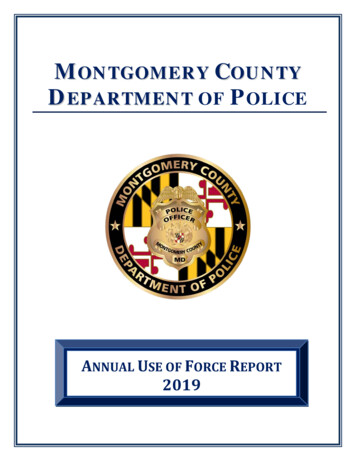
Transcription
M O N TGO M E R Y CO U N TYDEPARTMENT OF POLICEANNUAL USE OF FORCE REPORT2019
TABLE OF CONTENTSSECTIONChief’s MessageIntroductionStatistical OverviewAnalysisUse of Force in Response to Resistance by District of OccurrenceActivity When Force in Response to Resistance was UsedOffenses Where Force in Response to Resistance was UsedTypes of Force Used by Officers and SubjectsElectronic Control WeaponsInjuries to Officers and SubjectsMedical Treatment for Officers and SubjectsContributing FactorsDemographics of Subjects and OfficersOfficers Assaulted/AmbushedIn-Custody Deaths and Deadly Force IncidentsSummary1PAGE234577891012121414191921
Chief’s Message:The Montgomery County Police Department takes the use of force inresponse to resistance by its officers very seriously. That is why thesereports have been issued and shared with the public since 2002. Wehave a strict use of force policy as specified in department policy andprocedures. Montgomery County police officers receive extensive entrylevel and in-service training focused on using only the amount of forcenecessary to control an incident, affect an arrest, or protect themselvesor others from harm or death.We emphasize gaining compliance through an understanding ofpsychological factors and using communication skills to de-escalatesituations when possible, and to minimize the amount of force used. Atthe same time, it is important to recognize that use of force statistics canbe misread or misinterpreted. Just as the image of a police pursuit cancreate an image of a long, involved car chase, which is not the case, useof force in response to resistance can create the image of officers using their weapons which is notthe case in the vast majority of cases.In 2019, there were 553 uses of force in response to resistance reported, an increase of two percentfrom the year before. That means force was used by officers in 0.26 percent of the total dispatchedcalls for service, and only used in 3.3 percent of all arrests made by officers. In about 80 percent ofincidents, officers used no protective instruments or weapons. Instead, officers used only theirhands while attempting to place a subject in custody or otherwise gain control of them. Similarly,this was the most common type of force used against our officers by subjects, in a year in which thenumber of assaults on officers increased 19.7 percent.We believe that letting the public know what we do to enforce the law and how we do it is one ofthe cornerstones to forging a bond of trust and respect between the Department and the public weserve. We take complaints about inappropriate and unnecessary uses of force seriously; that is whyall complaints are promptly and thoroughly investigated by our Internal Affairs Division, and insome cases, these cases are reviewed by an agency outside of Montgomery County.There is a great deal of information contained in this report. I encourage you to contact me with anyspecific questions via e‐mail at CHIEFMCPD@montgomerycountymd.gov and we will respond toyour inquiries.Marcus G. JonesChief of Police2
INTRODUCTIONThe information presented in this annual report is obtained from the Use of Force reportscompleted by officers for incidents in calendar year 2019 where some type of force was used inresponse to resistance. This report is intended to provide an overview of these incidents and toalso identify trends and other issues that need to be addressed. Since each use of force report isreviewed by supervisors and command staff at various levels within the department, individualevents are not captured in this report, except for those that may involve unusual circumstances orneed further clarification.In addition, annual reporting and analysis of department use of force policies and procedures isrequired by the Commission on Accreditation for Law Enforcement Agencies (CALEA) to helpagencies identify policy modifications, trends, improve training and officer safety, and providetimely information for the agency to promptly address use of force issues. The Montgomery CountyDepartment of Police is dedicated to creating a culture of safety, transparency, and accountability.The Montgomery County Department of Police has been a CALEA-accredited law enforcementagency since 1993. The CALEA Law Enforcement Accreditation Program is the primary method fora police agency to voluntarily demonstrate their commitment to excellence in law enforcement bysystematically conducting an ongoing internal review and assessment of the agency’s operations,policies and procedures, and make adjustments wherever necessary to meet a body ofinternationally accepted standards.The authority to use force in response to resistance when legitimately required to do so remains afoundational pillar of the rule of law and is essential to keep communities safe and to protect theofficers charged with enforcing the law. Interactions with uncooperative subjects who arephysically resistant present situations that may quickly escalate. Ideally, an officer is able to gaincooperation in such situations through the use of verbal persuasion and de-escalation. However, ifthe situation requires it, an officer’s use of force to gain control in these and other circumstances isnecessary.Use of force in response to resistance by police officers is a necessary course of action to restoresafety and order in a community when all other means are ineffective. The level of force an officeruses in response to resistance varies based on the dynamics of each and every encounter.Because of this variation, guidelines for the use of force are generally based on many factors,including the officer’s level of training or experience, the nature of the perceived threat, the riskposed to officers and others, and the level of resistance posed by the subject. An officer’s goal is toregain control of the situation and subject as soon as possible, while at the same time protectingthemselves, their fellow officers, and members of the public that may be at risk.The police department’s Use of Force Policy (FC 131) states that officers may only use force which isobjectively reasonable to make an arrest; an investigatory stop/detention or other seizure; or in theperformance of their lawful duties, to protect themselves or others from personal attack, physicalresistance, harm, or death. The decision to exercise force must be based upon the circumstancesthat the officer reasonably believes to exist. In determining the appropriate level of force to be usedby an officer, the nature of the threat or resistance faced or perceived by the officer as compared tothe force employed should be considered. However, officers must sometimes make split-seconddecisions about the amount of force that is necessary in a particular situation, with limitedinformation and in circumstances that are tense, uncertain, and rapidly evolving.3
Nevertheless, when it is practicable, officers strive to always de-escalate a situation beforeresorting to using any type of force. Per department policy, an officer is required to complete aUse of Force Report, and an event report, for an incident that involves any of the followingcircumstances: Anytime force is used to counteract a physical struggle. Following the use of any force which results in an injury to an individual. When an individual claims to have been injured as a result of use of force. Whenever force is applied using a protective instrument. Whenever a firearm is discharged other than authorized target practice. Whenever a department canine inflicts injury on any subject or suspect in conjunction with acanine deployment. Anytime an officer is assaulted or ambushed.An on-duty patrol supervisor is required to respond to all Electronic Control Weapon (ECW)deployments, firearm discharges (except for the humane destruction of non-domestic animals), useof 12-gauge impact projectiles, and any use of force incident that results in serious bodily injury orin-custody death. Supervisors are also required to notify the MCPD Major Crimes Division of anysituations that meet the following criteria: All intentional firearm discharges by an employee, whether injuries occur or not, with theexception of authorized range practice or the destruction of dangerous or injured animals; All accidental firearm discharges by an employee that result in an injury to anyone, includingthe involved officer; and All incidents where an individual sustains life-threatening injury as a result of police action.All use of force reports are reviewed to verify compliance with department policy by a patrolsupervisor, a District Executive, and an Assistant Chief of the respective bureau depending on theorganizational component the involved officer(s) is assigned to. Moreover, the department’s BodyWorn Camera (BWC) program includes approximately 1,000 officers who are equipped withcameras. This technology helps document interactions between the police and individuals involvedin the majority of calls for service. The department’s use of force policy requires supervisors toreview all body camera footage captured for all incidents where officers use any type of force inresponse to resistance. These cameras help promote agency accountability and transparency, andare useful tools for increasing officer professionalism, improving officer training, preservingevidence, supporting prosecutions, and accurately documenting encounters with the public.STATISTICAL OVERVIEWBased on a comprehensive review and analysis of the use of force reports submitted by MCPDofficers in 2019, the following are highlights of the results that are detailed in various sectionsthroughout this report: MCPD officers reported a total of 553 use of force incidents in response to resistance. Force was only used by officers in 0.26% of the total dispatched calls for service. Force was used in 3.3% of all arrests made by officers.4
Three districts, Silver Spring (3D), Wheaton (4D), and Gaithersburg (6D) experiencedincreases in the number of reported use of force incidents from the previous year, while twodistricts, Rockville (1D) and Germantown (5D) reported decreases. The Bethesda District(2D) reported the same number of incidents. Making arrests (or attempting to make arrests), serving emergency evaluation petitions, anddefending against assaults constituted 92.9% of the incidents where some type of force inresponse to resistance was necessary. Calls for service involving assaults, narcotics/DUI offenses, mental illness, and disorderlyconduct accounted for 71.1% of all reported use of force incidents. The type of force most commonly used by officers in response to resistance was hands,which was used in 79.4% of use of force incidents, and it was also the most common type offorce used against officers by subjects (77.3%). Electronic Control Weapons (ECWs) deployments decreased 17.8%. Injuries sustained by officers decreased 32.9%, while injuries to subjects increased 1.4%. Asin previous years, the most common injuries reported by both officers and subjects werebruises/soreness and lacerations/abrasions. There was a 75% increase in the number of officers requiring first aid, and a 15.4% decreasein officers requiring treatment at hospitals for injuries sustained during use of forceincidents. There was an increase of 34.3% in subjects requiring first aid, and a decrease of14.3% in the number of subjects being transported to hospitals for treatment. Approximately 88% of the subjects involved in use of force incidents were reported to beunder the influence of alcohol and/or drugs, or suffering from some form of mental illness. Approximately 57% of the subjects involved in use of force incidents were African American.Caucasian subjects were involved in 20.3% of the incidents, Asian or Pacific Islandersubjects were involved in 2.0% of incidents, and Hispanic subjects were involved in 18.8%of use of force incidents. Subjects ages 18-39 accounted for 72.2% of the reported use of force incidents. The averageage of the subjects involved in use of force incidents was 31. Officers in the 21-39 age groups were involved in 77.9% of use of force incidents. Theaverage age of the officers involved in these incidents was 34. Approximately 78% of the subjects and 92% of the officers involved in reported use of forceincidents were male. The number of assaults reported on officers increased 19.7%, and no officers wereambushed. There were two deadly force-related incidents and no in-custody deaths reported.ANALYSISThe following table summarizes the calls for service, arrests, and use of force reports submitted in2019 compared to 2018.5
CategoryCalls for ServiceArrestsUse of Force Reports20192018211,25916,536553219,16218,592542% Change /-3.6-11.1 2.0This data indicates force being used in only 0.26% of the calls for service and 3.3% of the arrestsmade in 2019, compared to 0.25% of the calls for service and 2.9% of the arrests recorded in 2018.The incidence rate of the use of force compared to the calls for service and arrests has remainedrelatively consistent over the past five years (an average of 0.24% and 2.8% respectively), andindicates that for the overwhelming majority of calls for service and arrests, officers rarely useforce in response to resistance in the performance of their duties.A summary of MCPD activity for 2019 compared to 2018 is provided in the following chart.In 2019, there were 28 use of force-related cases opened involving 58 allegations received fromexternal and internal sources reviewed by the MCPD Internal Affairs Division (IAD), compared to20 cases and 34 allegations received in 2018. IAD ensures that all allegations, regardless oftheir source, are thoroughly reviewed and investigated, and that corrective action is taken forany improper conduct.IAD also ensures that employees are protected from unwarranted criticism for properly engaging intheir duties. Specific information regarding these investigations is summarized in IAD annualreports that are published on the department's website, and IAD also shares pertinent data as partof the County's Open [Government] Data Initiative (dataMontgomery), which is an integral elementof the department's community policing philosophy and ongoing commitment to maintaining aculture of transparency with the public. Summary information concerning allegations/complaintsbrought to the attention of IAD from external or internal sources can be reviewedat Internal-Affairs-Allegations/usip-62e2.6
USE OF FORCE IN RESPONSE TO RESISTANCE-DISTRICT OF OCCURRENCEIn 2019, use of force incidents in response to resistance reported in Silver Spring (3D) and Wheaton(4D) comprised more than half of the use of force incidents reported, which was also the case in2018.As shown in the chart below, two districts, Rockville (1D) and Germantown (5D), experienceddecreases in the number of reported use of force incidents in response to resistance in 2019compared to 2018. Three districts, Silver Spring (3D), Wheaton (4D), and Gaithersburg (6D)experienced increases, while the number of use of force incidents in response to resistancereported in Bethesda (2D) remained the same as the previous year.Note: District ‘00’ refers to incidents reported that occurred outside Montgomery County.Note: The uses of force incidents summarized in this report are based on the location (i.e., district)where force in response to resistance was used, not necessarily the district that the officers areassigned to or where the event may have originated.ACTIVITY WHEN FORCE IN RESPONSE TO RESISTANCE WAS USEDIn 2019, making or attempting to make an arrest, serving emergency evaluation petitions, anddefending against assaults accounted for 92.9% of the activities where officers needed to employsome type of force in response to resistance, compared to 91.9% reported in 2018.The activity-related data reported in 2019 compared to 2018 is shown in the chart on the nextpage.7
The category of “Other” includes situations such as traffic stops, serving search warrants, andtransporting prisoners, which accounted for 7.1% of the activities in 2019, compared to 8.1% in2018.OFFENSES WHERE FORCE IN RESPONSE TO RESISTANCE WAS USEDAssaults, mental illness-related calls, narcotics/DUI offenses and disorderly conduct accounted for71.1% of the use of force in response to resistance incidents reported in 2019, compared to 68.8%in 2018. The remaining percentage of incidents involved various other offenses such as larceny,burglary, weapons offenses, vandalism, trespassing, and other miscellaneous calls for service.A comparison of the primary offenses that comprised the majority of incidents where force was usedin response to resistance in 2019 and 2018 is shown in the chart below.8
The primary offense type that reflected the only increase in 2019 was assaults which increased26.8% compared to the previous year.TYPES OF FORCE USED BY OFFICERS AND SUBJECTSOfficersThe following series of charts show the breakdown of the leading types of force used by officers andsubjects in 2019 compared to 2018.The type of force most widely used by officers in response to resistance in 2019 was hands, whichwere used in 79.4% of the incidents reported, compared to 80.4% in 2018. Other types of forceused by officers in response to resistance in 2019 included knees and feet.In addition, flashlight use decreased by 50% and use of OC Spray increased 100% in 2019 comparedto 2018. There was also a decrease of 17.8% (8 fewer deployments) reported in the use of ElectronicControl Weapons (ECWs) in 2019 compared to the previous year. Officers discharged their serviceweapons in two incidents in 2019 which are summarized in the In-Custody Deaths and Deadly ForceIncidents section of this report.Note: It is important to point out that in some instances, more than one type of force in response toresistance may be used by one or more officers in an attempt to make an arrest or control asituation. During most calls for service, a primary officer is dispatched and at least one additionalofficer responds as a back-up unit. Consequently, in the majority of the circumstances where forcein response to resistance is used, two or more officers are typically involved.SubjectsThe chart on the next page shows the breakdown of the leading types of force used by subjectsagainst officers in 2019 compared to 2018.9
Note: In some incidents, there were subjects (and multiple subjects) that used more than one type of force againstofficers. The chart does not reflect ‘other’ types of force used by subjects.As is the case with the types of force used by officers, hands were also the most common type offorce used by subjects against officers in 2019, which accounted for 77.3% of incidents compared to71.9% in 2018. In 2019, there was a decrease in subjects’ use of feet (18.4%) and biting/spitting atofficers (28.6%). Other types of force used by subjects against officers included a rock, stick, pole,scissors, umbrella, and a vehicle.ELECTRONIC CONTROL WEAPONSThe department currently has 409 officers that are qualified and authorized to carry ElectronicControl Weapons (ECWs). These officers are required to complete extensive training andcertification prior to being issued an ECW. This training requires officers to attend 40 hours ofCrisis Intervention Training (CIT), and after successful completion, officers are also required tocomplete annual recertification training to be authorized to continue to carry an ECW.Note: The department is in the process of developing a multi-year plan to issue ECWs to all officerswhose assignments routinely involve public contact.In 2019, an ECW was deployed 37 times (in 35 incidents) compared to 45 uses (in 42 incidents) in2018. A detailed summary of ECW uses by district of occurrence is provided on the next page.10
Note: District designation ‘00’ represents those incidents
The Montgomery County Police Department takes the use of forcein response to resistance by its officers very seriously. That is why these reports have been issued and shared with the public We since 2002. have a strict use of force policy as specified in department policy and procedures. M

